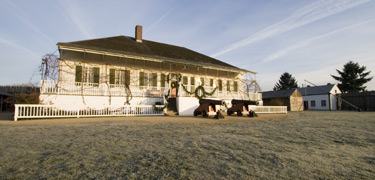Personal tools
Help
Tools
Class Notes
- Do you have news for fellow WSU alumni and other readers of Washington State Magazine? Send us your class note.
Our Story
written by alumni, faculty and friends.
NOTE: THIS IS A LEGACY SITE AND IS NOT REGULARLY MAINTAINED
Views
Getting a feel for Archaeology, uncovering Washginton's History
From Our Story
From Washington State Magazine, Spring 2005
Within musket range of the rebuilt Fort Vancouver, Patrice Hruska wields a common garden trowel to unearth an uncommon piece of Pacific Northwest history.
The chunk of brick that the Washington State University Vancouver anthropology student has found is a remnant of the old powder magazine at the Hudson’s Bay Company’s main supply depot in the region.
Though the building measured just 20 by 20 feet, the 14,000 pounds of gunpowder packed within its walls helped the fur-trading company wield great power in the early 1800s.
“It’s really kind of fun to dig something up that hasn’t been seen for 150 years or so,” says Hruska, one of more than a dozen WSU and Portland State University students enrolled in a seven-week archaeology field school at Fort Vancouver National Historic Site during Summer 2004. “It’s just a neat way to be a part of history and to get a feel for what archaeologists actually do.”
The powder magazine is next in line for historical re-creation at Fort Vancouver. But first the building’s foundation had to be relocated and, for the first time since the 1800s, entirely uncovered. That’s where the students came in.
“It’s an excellent way to teach archaeology,” says Doug Wilson, the National Park Service archaeologist directing the dig. “We’re trying to gather as much information as we can [about the powder magazine] and what kind of activities went on around it, so we can do a reconstruction of the building.”
To build the powder magazine, which dates to at least 1832, the Hudson’s Bay Company shipped bricks from England. Mortar was made with ground coral from the Sandwich Isles (Hawaii), and local Douglas fir lumber formed its roof.
Despite being in what Europeans considered vast wilderness, the fort was a cultural crossroads where more than 30 languages of nearby tribes and faraway lands could be heard. Many workers were Hawaiian, and Americans later dubbed the nearby village Kanaka, after a Polynesian word meaning “people.”
From its Fort Vancouver headquarters, the British company’s goal was to trap out the region’s beavers south of the Columbia River, thus creating a “fur desert” to eliminate American competition for lucrative pelts, says Vanessa Ross (’00 Biol.), a graduate student in anthropology in Pullman.
A decade after U.S. troops established a fort in 1849, however, relations soured, and the company left Fort Vancouver. The fort later burned, and its most durable building was abandoned to history—scavenged for its bricks, then hidden beneath layers of flood debris, World War II sawmill waste, and blankets of sod.
In 1947, archaeologist Louis Caywood uncovered part of the powder magazine for the first time in 80 years. The finding gave the park service a reference point to reconstruct the wooden fort buildings and stockade in the original locations, Wilson says. A generation later, the site was disturbed twice again, then lay buried for 30 more years.
Besides bricks, student archaeologists have found whole nails, shards of pottery, grape shot for cannons, pieces of glass, and many other artifacts, including a curiously high number of clay smoking pipes.
“You’d imagine this would be a no-smoking zone,” Wilson joked.
Beth Horton, a Ph.D. candidate in anthropology in Pullman and a supervisor at the field school, says Fort Vancouver is prized for historical study because so much has survived. “Usually you have to abstract the bigger picture. Here, it’s all there.”
Sara Williams is a senior at WSU Vancouver and president of the campus anthropology club. After field school, she stayed on as a volunteer to continue digging and processing artifacts.
“It’s what I had expected and then some,” she says. “Reading about [archaeology] is one thing. You get so much more out of it by doing the field school.”
Our Story site map
Our Story main page | Our Story categories | Help Desk
Contact | Give | Advertise
Washington State Magazine | Washington State University | Class Notes
Our Story is coordinated by
In partnership with
Our Story and Washington State Magazine are publications of Washington State University. All rights reserved.
P.O. Box 641227, Washington State University, Pullman, WA 99164-1227 USA | wsm@wsu.edu, 509-335-2388
Accessibility | Copyright | Policies

